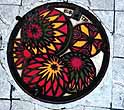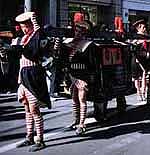
Castles big and small, real and reconstructedOutside in the morning, rather frosty and very clear, blue skies in contrast to yesterday's rain. Not a lot of traffic about because it's a national holiday: Culture Day. I walked down to the castle, expecting to see it rising up beyond its moat, but no - turns out it's a smaller model. The moat was choked with large, dried-out dead and odd-looking plants, which I think must've been lotus. (Lotuses? Loti?) Finally found the castle, and although the hour was early and nothing was open, some English on the informative signs indicated that it was a reconstruction, just five years old, built on the foundations of the original, which burned down a long time ago. Well, no great loss - in a couple hours I'd be in Matsumoto, home to one of the finest examples of the Japanese castle standing, and it's the original (unlike the better-known Osaka castle). Visiting it wasn't a priority, however; since I'd already done that, in 1990. I wanted to return to Matsumoto for the temari.After my second trip to Japan I found a book about this obscure craft in LA's Little Tokyo. Seeing some actual balls at a Japan Cultural Fair in Torrance triggered memories of seeing them here, and I asked the elderly lady at the fair's display if she'd teach me how to make them, and she did, and I stopped counting after I'd sewn 150 of them. (Examples of my work are to the left.) Since then I've wanted to return to Matsumoto to see what's available there concerning this craft, maybe I could pick up some tips. So just after my train arrived, I stowed my bag in a coin locker and made haste for the nearby Tourist Information Center to ask about them. The woman running the booth was rather surprised by my questions, and was somewhat deflating - with a mild sneer she dismissed the subject - "just a toy." Well! Still, all the local gift shops had some for sale, and they showed up all over, even on the manhole covers: 
The town (small city, really) was full of people; it
was sunny and almost warm. I'd arrived at noon, and
just followed the crowd - I'd thought the scene might
be more like a neighborhood festival or matsuri,
one of those Japanese events I have yet to experience,
where they carry around the big portable shrines
called mikoshi (three of these were set up
Eventually I'd had enough and fled, escaping to the town's outskirts on the private Highland Kamikochi Detetsu line. This was a brightly painted train which slides back and forth along a single track, stopping at a dozen stations along the way. My destination was perhaps a kilometer beyond the Oniwa station, the Japanese Ukiyo-e Museum, or JUM. Good stuff - an artist * named Kuniyoshi was featured in the main gallery - he'd made some intriguing images, but the interpretations I found in the English captions of the oeuvre's standard pictures hanging in the corridors outside were also enlightening - for example I learned that Hokusai's Wave is actually known as "namiura" or the "Underside of a Wave..." which is usually translated fully as "In The Hollow of a Wave (off the Coast at Kanagawa)" - but everybody calls it the Great Wave. After riding the train back into town I retrieved my bag and walked over to the Matsumoto Tourist Hotel to check in. (Hmmm - this ahead-of-time reserving pays off - another almost-top floor room in this high-rise.) Then I went out for food but found the pickings a little slim, many places closed for the holiday (the Festival had ended at dusk). Wound up at a mechanical sushi bar near the station, watching the television showing Japan beating the USA team in the World Cup of Women's Volleyball. Next: Hotaka WasabiNote: *
I've also learned that the custom of giving all the
credit to a single personage (like Hiroshige) isn't
quite correct, with these wood block prints - four
separate people were actually responsible, each with
a key role in their production: the original artist,
who gave his drawings to the carver of the wood
blocks; the printer who used those, and the government
censor who approved the final product for public
sale - his stamp can be found somewhere on the
illustration, or maybe on its border. |

